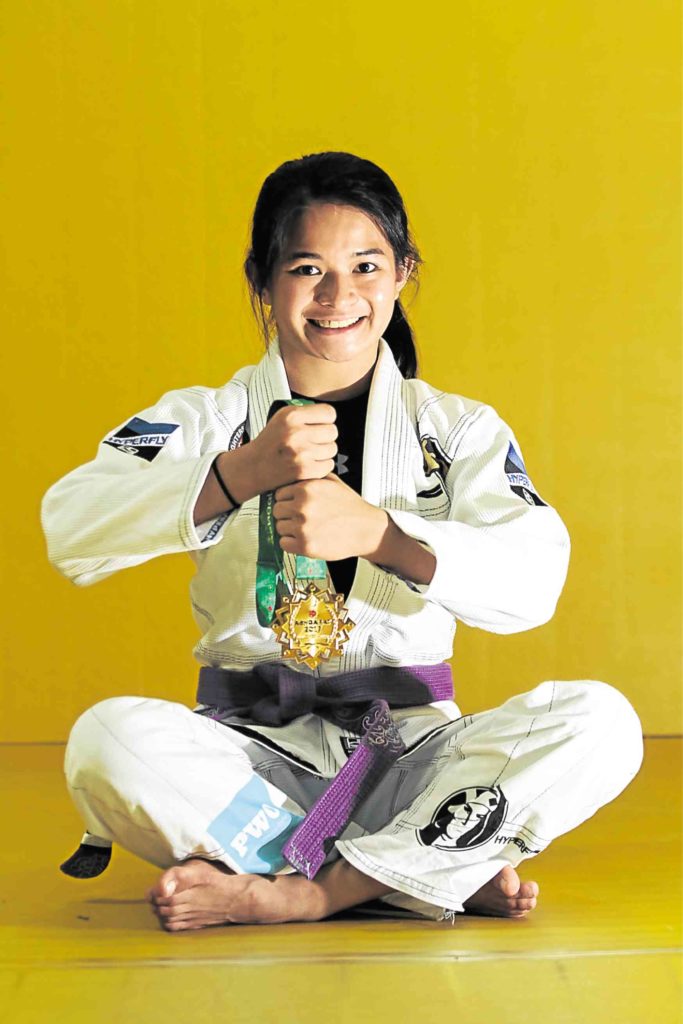Ladies first
Margaret “Meggie” Ochoa unlocks the door to her gym and enters into what looks like a splash of sunshine.
Covered in bright yellow wall-to-floor padding, the room matches the jiu-jitsu champion’s cheery disposition.
“People usually confuse jiu-jitsu with MMA (mixed martial arts), UFC (Ultimate Fighting Championship),” says Ochoa. “But there’s no striking in jiu-jitsu.”
“In jiu-jitsu, even if you’re not athletic, you can excel as long as you’re smart,” she adds. “You should know what to do at the right moment, the proper reaction to what your opponent is going to do. It’s kind of like chess—physical chess.”
About 13 kilometers away, another building houses the martial arts academy of John Baylon, the Filipino judo legend who had dominated the Southeast Asian Games for two decades.
And it’s in this gym where another champion female fighter, Annie Ramirez, trains diligently. Under Baylon, Ramirez transformed from a local judo sensation into an international jiu-jitsu champion.
“It’s hard work,” says Ramirez. “No matter how talented you are, if you don’t give your best you’ll get beaten by the person who really worked hard. The world champions, even if they almost bleed from training, they keep going.”
There’s a similar thread to Ramirez and Ochoa’s journey to the top. Both had moments when they could’ve given up on sports altogether.
Mediocre in athletics
Take Ochoa: Before finding success in jiu-jitsu, the petite athlete admitted to a mediocre stint with the Ateneo track and field team.
“In track and field, to be honest, I never excelled,” shares Ochoa. “In track, how your body is, matters—the kind of muscles that you have, your height, your stride length, the height of your jump. How hard you train, of course it’s there. But if you don’t have the body for it, you’ll never be at par with the top-level athletes.”
Ramirez, too, had a rough start in judo that she considered “being a referee instead.”
But the 5-foot-4 judoka found success in the collegiate scene after sliding down the weight class. Ramirez powered University of Santo Tomas to UAAP titles, won the MVP award twice, and eventually, got recruited by the national team.
But it wasn’t the rosy stint she expected.
“In judo, I never had a medal in international competitions. Even the minor invitationals, my best finish was fifth place,” Ramirez recalls.
But failures failed to daunt both girls.
Ochoa tried mixed martial arts, enjoyed it so much that it drew out her competitive streak again. The five-foot fighter, though, could hardly find a competitor her size so a coach suggested she switch to jiu-jitsu.
“I tried it, I loved it; I started joining competitions and I started winning competitions which never used to happen,” Ochoa says with a laugh. “I won my first competition so I thought this is different. It’s technique over power, so whatever body type you have, you can excel. I’m small, so in other sports, I may not excel. But in jiu-jitsu, you can find a way.”
For Ramirez, jiu-jitsu has always been on the side. As a judoka, she practiced jiu-jitsu to polish her grappling. But Ramirez soon discovered how it could be the other way around—her judo background enhancing her jiu-jitsu skills.
“When I started to shift, it was hard,” Ramirez says of jiu-jitsu, which focuses more on ground fighting compared to judo. “There are similarities, but some rules also contradict.”
Big add-on
“But having a judo background is a big add-on,” she says. “Mentally, it affects the opponent when you have a martial arts background. It’s like I already ran 100 meters and you’re just starting.”
While success on the mat came quick for Ramirez and Ochoa, there were also struggles off it.
Before Philippine jiu-jitsu got recognized as a national sports federation late 2015, fighters who wanted to compete internationally shelled out personal funds.
So when Ochoa wanted to compete in the 2014 International Brazilian Jiu-Jitsu Federation (IBJJF) World Championship in Long Beach, California, she decided to join a crowd-funding site, an online tool that helps people achieve a goal or advocacy through contributions from anonymous netizens.
To her surprise, donations helped defray the hefty cost of her bid. And Ochoa did not disappoint as she bagged a gold right in her world debut. The 27-year-old defended her title in the next two years and, finally, as a member of the national team, picked up a gold in the 2016 Asian Beach Games.
Ramirez also struck gold when jiu-jitsu debuted in the 2014 Asian Beach Games, then defended her continental crown in the 2016 edition.
“It’s a growing sport,” says the 26-year-old Ramirez. “We really spend to look for competitions out of the country or train in strong clubs in the US.”
“In the Southeast Asian level, 100 percent we’re up there,” Ochoa notes. “If it’s included in the Southeast Asian Games, I’m sure many can deliver gold medals. In the Asian level, we’re at par with top athletes. Japan and Korea are top level. We’re not in the high level as them, but we can if we work more.”
Last September, Ochoa and Ramirez bagged the Philippines’ only gold medals in the 5th Asian Indoor and Martial Arts Games in Ashgabat, Turkmenistan. The triumph earned them P2 million each as incentive from the government.
For Ochoa, it sure was a long way from virtually begging for funds just to compete.
“There are so many people part of this journey,” she says. “Right from the beginning, my goal was to win the world title in every belt level. I also never thought we’d have a national team, so this is definitely beyond expectation. It was just a dream to represent the Philippines officially. I credit everything to God for putting me here.”
Giving back
For Ramirez, it was a journey to finding her true calling. “My first love is judo, my true love is jiu-jitsu,” she says.
And this passion gets shared as both find time to mentor. Ochoa volunteers to teach abused women and children.
“I really want to make it sustainable,” she says. “I want it to grow into a movement that’s not just for healing but also for prevention.”
Through jiu-jitsu, both hope they can do more for others. Do more to better themselves. Do more to bring honor to the country.
But to do more, Ramirez and Ochoa know that every day, they have to work hard and go back to where it all started: right at the gym.

